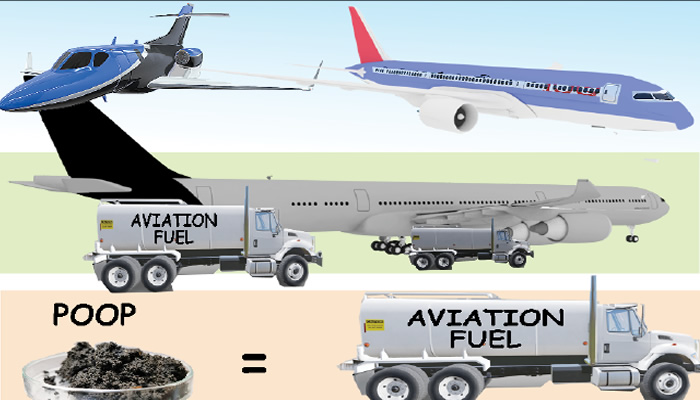
In the competition for sustainable jet fuel alternatives, some businesses are getting inventive.
Planes have been reported to run on used cooking oil. But what about jet fuel made completely of human faeces?
Firefly Green Fuels, a Gloucestershire, United Kingdom-based aviation company, has developed just that, which is generating a buzz across continents.
Although sustainable aviation fuel is not a novel concept, using wet human waste (sewage), a plentiful and inevitable waste, is.
Human waste, over the years, has been dumped in the sewage tank, showing that it is not useful for anything else. However, research has shown that it can come in handy in the aviation sector, and become a game-changer, especially in fueling airplanes.
According to researchers, discarded “wet waste” materials — organic waste including human waste, animal manure, and wastewater sludge, Inverse Innovation, explains — can be converted into biofuel to power jets.
Before Firefly Green Fuel’s innovation, in 2021, a research team which was led by the United States National Renewable Energy Laboratory published a study in the journal, “Proceedings of the National Academy of Sciences,” describing how to convert wet waste into paraffin, which is used in aviation fuel.
Their findings, experts have noted, could make it easier to power jets with greener, more eco-friendly fuel.
Unlike traditional production methods for biofuels, the new approach described in the study uses a chemical process to efficiently remove excess water from wet waste, mostly faeces, and then isolate the combustible materials needed to make fuel.
This method, according to the US Civil Aviation Authority, could potentially cut aviation emission levels by a whopping 165 percent. Since the aviation industry contributes two-and-a-half percent of all the planet’s greenhouse gases, this would be a significant improvement.
According to the study’s authors, “While renewable natural gas targets an enormous US market, producing liquid hydrocarbon fuels from wet waste offers the potential to address the challenge of decarbonising the aviation sector.”
Although the team has only tested a few hundred milliliters of the new sustainable fuel so far — not nearly enough to power a commercial jet — further research will be conducted to make the future of jet fuel more sustainable.
An article on Popular Mechanics, an online resource in 2021, titled, “Your poops can power planes,” noted that the idea might be considered pretty gross, adding that it might be great for the planet.
Both food and animal waste contribute over 8.5 percent to greenhouse emissions but this new fuel, according to researchers, could reduce airline emissions to zero and beyond.
A biogas expert based in the United States, Dr Charley Egwu, said the experiment demonstrated the ability of “wet” human waste, like rotting food and sewage, to power airplanes.
Egwu said the recycled fuel could vanquish airline emissions and reduce waste, creating a “165 (per cent0 reduction” overall, according to the scientists. That represents about four percent of total greenhouse gases.
The secret, according to him, is volatile fatty acids, converted from a waste product into paraffin, a popular combustible jet fuel ingredient.
Quoting the US National Renewable Energy Laboratory, he said, “Over 21 billion gallons of jet fuel are consumed in the United States annually, with demand expected to double by 2050.”
He added that sustainable aviation fuels comprised a significant portion of the aviation sector’s strategy for CO2 reductions given the limited near-term prospects for electrification.
“In addition, the low aromatic content of current SAF (sustainable aviation fuel) routes has been shown to reduce soot formation and aviation-related aerosol emissions by 50 to 70 (percent). Soot is the primary nucleator of contrails, which have a larger effective radiative force (57.4 mW/m2) than aviation-emitted CO2 alone (34.3 mW/m2),” Egwu said.
“This content is imported from the poll. You may be able to find the same content in another format, or you may be able to find more information, at their website.
“There’s a key snag in reducing airline emissions; it’s much harder to develop a hybrid, electric, or other alternative fuel source plane than it was to begin developing consumer vehicles on the ground.
“But there’s a key upside, too; jet fuel has lower purity requirements than gasoline for cars. Researchers have crowded into the space to search for recycled or renewable fuels that will still power basically regular airplanes,” he added.
What is wet waste?
Wet waste includes everything from flushed toilet water to rotting food waste, to faeces. By nature, they are all typically biodegradable, but still generate further waste — like the methane generated by landfills. This can be harvested. However, some scientists said the process was inefficient.
For instance, in their new study, the NREL scientists described draining wet waste of water and then catalysing it into fungible (virtually identical and swappable one-to-one) hydrocarbons for airplane fuel.
The new way to extract and blend resulted in more efficient, better-burning jet fuel that can safely replace a higher percentage of hydrocarbons in the final blend.
This can be like a hypothetical ethanol that can replace over 70 percent of gasoline in one’s car.
A field researcher in renewable energy resources, Josh Alaba, noted that to do this conversion, scientists would take wet waste that was typically turned into methane and slow the process so that more complex hydrocarbons emerged.
Alaba added, “It’s a huge improvement, and the cost is reasonable. Techno-economic analysis for VFA catalyst upgrading determined that VFAs can be produced at $0.30/kg to achieve a fast-track minimum fuel selling price of $2.50/gallon.
“There’s enough viable wet waste to replace 20 percent of overall airplane fuel, which also means diverting the wet waste from the methane-producing landfill cycle. This is how the reduction in emissions goes past 100 percent all the way to 165 percent.”
He also added that for the skies to remain friendly, the aviation industry must lower its emissions and fewer contrails, both generating and trapping less greenhouse gas around the world.
He added, “This new way to catalyse wet waste into paraffin both efficiently and at a reasonable cost could also help to reduce the high energy cost of spoiled food and other wet waste in the first place.”
Aviation emissions
The aviation industry is one of the three sectors with the highest emissions. The other two include energy use in industries like textile or car manufacturing, and energy use for generating electricity and heat.
Within the transportation industry, aviation is the second largest contributor of emissions after highway traffic.
The United States contributes to emissions dump with the staggering 21 billion gallons of jet fuel it consumes each year as a result of aviation, according to its Bureau of Statistics.
The Nigerian aviation industry, like its global counterparts, faces challenges in terms of sustainability. It is estimated that aviation contributes approximately four percent to human-induced global warming, emitting around one billion tons of CO2 annually, which is more than the emissions of many countries.
The International Civil Aviation Organisation predicted that air passenger numbers would double by 2030, leading to increased air pollution and associated health risks.
Recognising the need for change, the Nigeria Civil Aviation Authority is actively seeking solutions to reduce the sector’s impact on climate change.
The agency has said it aims to improve environmental and societal impacts through innovative practices while contributing to the national economy. Collaboration with industry stakeholders is a key aspect of achieving the ambitious goal of a 50 percent reduction in net carbon emissions by 2060.
At the National Aviation Conference held in June 2023 in Abuja, the then-director general of Nigeria Civil Aviation Authority, Musa Nuhu, in his presentation on aviation sustainability, said the agency “seeks solutions to improve the societal and environmental impacts of air transportation, reducing the sector’s contribution to climate change through new practices and innovation while increasing the sector’s contribution to the national economy.”
Furthermore, one example of sustainability in the Nigerian aviation industry is Aero Contractors’ acquisition of the Bombardier Q400 aircraft.
This aircraft is known for being the quietest in the world, with a noise footprint much smaller than other aircraft.
Similarly, it is fuel-efficient, emitting 30 to 40 percent fewer emissions compared to other aircraft. The introduction of such eco-friendly aircraft demonstrates the industry’s commitment to sustainability.
Enhancing fuel efficiency, doing away with single-use plastics, offering locally sourced and seasonal food options, and educating passengers are just a few of the ways the industry can lessen its environmental impact and carbon footprint.
Aside from their carbon emissions, airplanes also release non-carbon pollutants such as soot, nitrogen oxides, water vapor, and carbon monoxide which contribute to global warming. Global warming is significantly impacted by these pollutants, and as a result, there is growing pressure on the aviation sector to lower emissions.
By 2050, the industry intends to attain net-zero carbon emissions.
According to an article in Sustainability Accounting, Management, and Policy Journal, “Over the past 50 years global demand for air travel has risen by nine percent per annum and growth (at a reduced rate of three to seven percent) is predicted for the next 20 years.”
There is still work to be done in the Nigerian aviation industry’s sustainability, despite the recent advancements. The need for creative ways to solve sustainability issues is growing along with the demand for air travel.
“Over the past 50 years, global demand for air travel has risen by nine percent per annum, and growth (at a reduced rate of three to seven percent) is predicted for the next 20 years,” the article read in part.
However, an aviation engineer, Dr Ali Muhammed, said the industry was not ignorant of the problem.
“For instance, in 2018, in America, United Airlines set a 50 percent carbon reduction goal before 2050. But the airline also acknowledged meeting this goal ultimately depends on innovations like this one. Nigeria still has a lot of work to be done but the innovation by Aero is a good way to start,” Muhammed added.
Sustainability
In the groundbreaking research on poop-to-aviation fuel, the scientists proposed a circular manufacturing process. They argued, essentially, that because humans would relieve themselves on airlines, waste would, with this production method in place, power their future flights.
The paper’s authors argued their process had the potential to account for 20 percent of the US’s jet fuel consumption, bringing the aviation industry one step closer to reaching the coveted “net zero” for fuel consumption.
The aviation sector can become greener and more environmentally conscious by concentrating on fuel efficiency, reducing non-carbon pollutants, and implementing sustainable practices, even though reaching zero emissions may be a long way off.
By adopting sustainability, the sector can foresee consumer trends, take the lead in environmentally friendly aircraft, and make the world a safer place.














